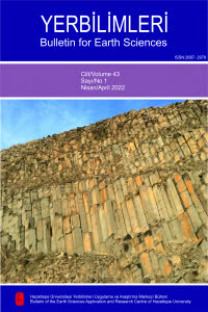Germik Formasyonu Oligosen Evaporitlerinin (Kurtalan, GB Siirt) Diyajenezi ve Paleocoğrafik Gelişimi, Türkiye
Anhidrit, diyajenez, Germik Formasyonu, ikincil jips, Kurtalan, sabka, sığ deniz
Diagenesis and Paleogeographic Development of Oligocene Evaporites of the Germik Formation (Kurtalan, SW Siirt), Turkey
Anhydrite, diagenesis, Germik Formation, Kurtalan, sabkha, secondary gypsum, shallow sea,
___
- Back, W., Hanshaw, B.B., Plummer, L.N., Tahn, P.H., Rightmire, C.T., and Rubin, M.,
- 19 Process and rate of dedolomiti
- zation: Mass transfer and 14C dating in a
- regional carbonate aquifer. Geol. Surv.
- Amer. Bull., 94, 1415-1429.
- Butler, G. P., Kendall, C. G. St. C., Kinsman, D. J. J., Shearman, D. J., and Skipwith, A. d’E., 1964. Recent anhydrite from the
- Trucial Coast of the Arabian Gulf. Geolo
- gical Society of London, Circular, 120, 3.
- Butler, G. P.,1969. Modern evaporite deposition and geochemistry of coexisting brines, the sabkha, Trucial Coast, Arabian Gulf. Journal of Sedimentary Petrology, 39, 70–89.
- Caldwell, R. H., 1976. Holocene gypsum depo- sits of the Bullara Sunkland, Carnarvon Basin, Western Australia (PhD Thesis). Univ. Western, Australia (unpublished).
- Coşkun, B., 2004. Arabian-Anatolian plate mo- vements and related trends in southe- ast Turkey’s oilfields. Energy Sources, 26, 987–1003.
- Curtis, R., Evans, G., Kinsman, D. J. J., and Shearman, D. J., 1963. Association of dolomite and anhydrite in recent sedi- ments of the Persian Gulf. Nature, l97, 679–680.
- Dağıstan, H., and Şimşek, S., 2005. Geological and hydrogeological investigation of Kozluk-Taşlıdere (Batman) geothermal field. Proceedings World Geothermal Congress, (eds.) 1–8.
- Gilmour, N., and Makel, G., 1996. 3D Geometry and kinematics of the N.V. Turkse Shell thrust belt oil fields, Southeast Turkey. Musee National d’Historie Naturella, 170, 524–547.
- Günay, Y., 1998. Güneydoğu Anadolu’nun jeo- lojisi. TPAO, 3939., Ankara (Türkçe).
- Gündoğan, İ., Önal, M., and Depçi, T., 2005. Sedimentology, petrography and dia- genesis of Eocene-Oligocene evapori- tes: the Tuzhisar Formation, SW Sivas Basin, Turkey. Journal of Asian Earth Science, 25, 791–803.
- Hardie, L. A., and Eugster, H. P., 1971. The de- positional environment of marine eva- porites a case for shallow, clastic accu- mulation. Sedimentology, 16, 187–220.
- Hardie, L.A., 1984. Evaporites: Marine or non- marine? American Journal of Science, 284, 193–240.
- Kasprzyk., A., and Orti., F., 1998. Paleogeog- raphic and burial controls on anhydrite genesie: a case study from the bade- nian evaporite basine of the carpathian fordeep (southern Poland, western Uk- raine). Sedimentology, 45, 889-907.
- Kendall, A. C., 1981. Continental and supratidal (sabkha) evaporites. İn: Facies Models. Geoscience, 1, 145–157.
- Kinsman, D. J. J., 1969. Models of formation, sedimentary associations and diag- nositic features of shallowwater and supratidal evaporites. Am. Assoc. Petr. Geol., 53, 830-840.
- Maxon, J. H., 1936. Geology of petroleum pos- sibilities of the Hermis dome. MTA, 255., Ankara (İngilizce).
- Mossop, G. D., and Shearman, D.J., 1973. Ori- gins of secondary gypsum rocks. Trans. İnst. Min. Metal, 82, 147–154. 21
- ISSN: 1301-2894
- Yayın Aralığı: 3
- Başlangıç: 1976
- Yayıncı: Hacettepe Üniversitesi Yerbilimleri Uygulama ve Araştırma Merkezi
Yapay Sinir Ağı Yöntemi ile Manyetotellürik Veride Sinyal ve Gürültü Ayırımı
EBRU ŞENGÜL ULUOCAK, Emin U. ULUGERGERLİ, Hilal GÖKTAŞ
Geliştirilmiş Eğim Açısı Toplam Yatay Türevi ile Manyetik Kaynakların Sınırlarının Belirlenmesi
Muzaffer Özgü ARISOY, Ünal DİKMEN
Ankara için Deprem Olasılığı Tahminleri
